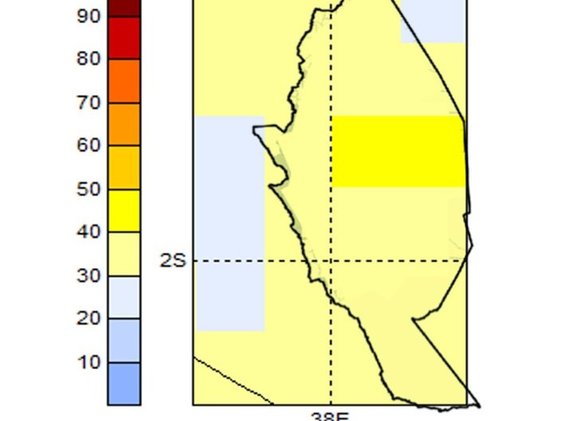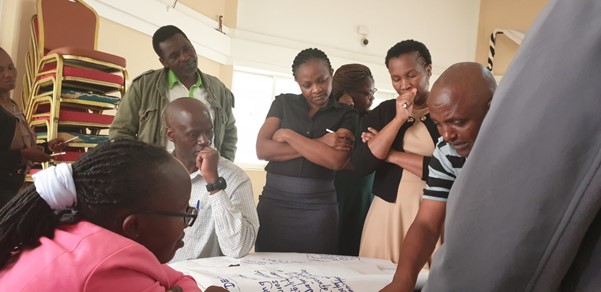How can we mainstream anticipatory action in disaster risk-management systems?
Many agencies have made significant efforts to scale up and mainstream anticipatory action approaches to reduce the impacts of disasters. But the anticipatory action community has much less experience of working within national disaster risk-management systems to integrate anticipatory action.
Working within disaster risk-management systems offers opportunities to scale up anticipatory action and increase its long-term sustainability. Our research shows huge interest and motivation among decision-makers in Kenya to use forecasts more systematically to manage drought risk. But what are the challenges posed by trying to modify existing systems to integrate anticipatory action? Our recent research paper set out to answer this question, drawing on experiences from the ForPAc project about how to move towards a more anticipatory approach within Kenya’s drought risk-management system.
How does Kenya manage drought risk?
Kenya’s drought risk-management system is intricate, having evolved from a project in the early 2000s to the current multifaceted system. It is coordinated by the National Drought Management Authority (established in 2012) and based on a two-tier structure of national- and county-level processes.
At the national level, decisions are made through the Kenya Food Security Meeting (an advisory body) and the Kenya Food Security Steering Group (a technical body). The latter provides multi-agency of food security status-monitoring, assessment and prognosis for Kenya after the March-April-May (MAM) and October-November-December (OND) seasons.
At the county level, drought management is conducted through the county steering group, which comprises county-level government officials and development partners. It oversees the production of county early warning bulletins each month and prepares drought-contingency plans. The bulletins classify stages of drought based on a variety of biophysical, vegetation and socio-economic indicators. Reaching an ‘alarm phase’ classification triggers funding from the National Drought Contingency Fund.
How is forecast information used in the current system?
The Kenya Meteorological Department produces forecast information relevant to drought management, such as seasonal, month-ahead and decadal agrometeorological bulletins (Figure 1), but these are not systematically used in drought management. International forecasts are used in national-level rain assessments, but the information does not inform food prognoses nor preparedness actions, and is not included in county-level drought management processes.

Research shows that climate information perceived to be accurate, credible, salient and timely for decision-making is more likely to be used. However, forecasts currently produced in Kenya could be better suited to decision-makers’ needs. For example, the production and communication of forecasts is not synchronized with drought-planning and decision-making processes. Moreover, rainfall forecasts such as those issued by the Kenya Meteorological Department do not align with the indicators used in the county-level drought management system, which uses the Standardized Precipitation Index (SPI) and Vegetation Condition Index (VCI), along with other socio-economic indicators of drought and food insecurity.
Moreover, forecasts do not currently include skill information (information about the accuracy of the forecasts) and not all forecasts include probabilities. As a result, stakeholders do not know how often forecast-based actions might turn out to be unnecessary or based on ‘false alarms’.
Differences between institutional structures and a lack of information sharing have also hindered interaction between users and producers of climate information in Kenya. Above all, even if forecasts that use the drought early warning system (DEWS) metrics were provided, acting systematically on probabilistic forecast information would require enhanced capacity among the users of these forecasts.
Opportunities to use weather and climate information in the DEWS
Our research sought to advance the uptake of ‘usable’ climate information. Based on feedback with county-level stakeholders, we co-produced forecast products that better matched the DEWS, being timely and salient (Figures 2 and 3). These included: (1) long lead (issued in July) OND forecasts that aligned with the March–May rain season assessments (Colman et al. 2020); (2) probabilistic seasonal and month-ahead forecast for the decision-relevant SPI; (3) six-weeks-ahead VCI forecasts (Barrett et al. 2020); and (4) end-of-season soil moisture forecasts updated monthly to support agricultural decision-making (Boult et al.2020).


Figure 3a and b. Examples of prototype SPI forecasts (2 above) co-produced seasonal rainfall forecasts, showing the forecast probability of SPI3 for Oct-Nov-Dec season being below the critical SPI3 threshold (of -0.09) used to trigger the drought ‘Alert’ phase classification. The left-side image shows a Kenya-wide map for Oct-Nov-Dec 2020, issued in July 2020; the right-side image shows Kitui county only for Oct-Nov-Dec 2019, issued in July 2019. The climatological probability of SPI3 being less than the critical threshold is 46 per cent, and is marked by a bold line on the colour bar.


Figure 3a and b. Examples of prototype SPI forecasts (2 above) co-produced seasonal rainfall forecasts, showing the forecast probability of SPI3 for Oct-Nov-Dec season being below the critical SPI3 threshold (of -0.09) used to trigger the drought ‘Alert’ phase classification. The left-side image shows a Kenya-wide map for Oct-Nov-Dec 2020, issued in July 2020; the right-side image shows Kitui county only for Oct-Nov-Dec 2019, issued in July 2019. The climatological probability of SPI3 being less than the critical threshold is 46 per cent, and is marked by a bold line on the colour bar.
Next, we piloted the new forecasts and associated skill information with decision-makers through a series of monthly workshops during the OND 2019 season. These provided a platform for training about how to interpret the prototype forecasts, as well as an opportunity to explore actions that could be based on this. Workshops were synchronized with steering group meetings, which allowed forecasters to interact regularly with users and provide forecast updates when decision-makers needed further information.
Throughout the pilot, stakeholders identified actions that could be informed by the above average forecast information. These included: planting more maize than normal; vaccinating livestock against diseases such as yellow fever (due to above-normal likelihood of wet conditions); and enhanced water-harvesting initiatives.

Structural issues and questions of finance
Despite these positive outcomes, our research pointed to underlying issues that influence the effectiveness of efforts to integrate forecasts into an existing risk-management system to make it anticipatory.
Although there are several funds available for risk management in Kenya, there are no designated funds for anticipatory risk management. As such, there are limited incentives to integrate forecasts into existing early warning systems and move towards anticipatory approaches. The disaster policy landscape also needs to support data exchange, institutional collaboration and funding for anticipatory risk management.
Early warning information should support early action, and this should be linked to forecast-based financing such as the National Drought Emergency Fund, which should draw funds from the national treasury.
Conclusions
Despite the lack of clear funding strategies for anticipatory drought risk management in Kenya, there is significant interest and enthusiasm to use forecasts more systematically with the current drought risk-management structure and personnel in Kenya. Since our research, Kenya’s National Drought Management Authority has made significant strides in including forecast information (e.g., VCI outlooks) within their county bulletins (see, for example, its Kitui county bulletins).
However, scaling anticipatory action by integrating it into existing government-led risk management systems is resource intensive, and requires buy-in and common understanding among all stakeholders. To be sustainable, Kenya needs funding and policy frameworks that are conducive to anticipatory action.
References
Barrett, A.B., Duivenvoorden, S., Salakpi, E.E., Muthoka, J.M., Mwangi, J., Oliver, S. and Rowhani, P. ‘Forecasting Vegetation Condition for Drought Early Warning Systems in Pastoral Communities in Kenya’ in Remote Sensing of Environment, Vol. 248, pp. 111886, 2020. https://doi.org/10.1016/j.rse.2020.111886
Boult, V.L., Asfaw, D.T., Young, M., Maidment, R., Mwangi, E., Ambani, M., Waruru, S., Otieno, G., Todd, M. and Black, E. ‘Evaluation and Validation of TAMSAT-ALERT Soil Moisture and WRSI for Use in Drought Anticipatory Action’ in Meteorological Applications, Vol. 27(5) pp. e1959, 2020. https://doi.org/10.1002/met.1959
Colman, A.W., Graham, R.J. and Davey, M.K. ‘Direct and Indirect Seasonal Rainfall Forecasts for East Africa Using Global Dynamical Models’ in International Journal of Climatology, Vol. 40(2) pp. 1132-1148, 2020. https://doi.org/10.1002/joc.6260
Taylor, O., Mwangi, E., Visman, E., Todd, M., Kniveton, D., Rowhani, P., Waruru, S., Mwangi, J., Colman, A., Graham, R., Kilavi, M., Ndegwa, W., & Macleod, D. 'ForPAc Case Study: Co-producing Approaches to Forecast-based Early Action for Drought and Floods in Kenya'. WISER co-production manual, 2020. futureclimateafrica.org/coproduction-manual/downloads/WISER-FCFA-coproduction–case-study-20.pdf
This blog was written by Olivia Taylor and Emmah Mwangi, University of Sussex.
The ForPAc project – Toward Forecast-based Preparedness Action – was funded through the SHEAR research consortia. It was based on strong UK-Kenya partnerships and focused on Kenya’s drought risk-management system.
ForPAc: Forecast-based Preparedness Action
This video describes ForPAc’s interventions in Kenya’s drought risk-management system, as well as work on flooding and regional forecasting.
Play Video

